Archive for the ‘cryptozoology’ Category
“Return to Wildcat Mountain” is Now Out on Prime Video!
Posted in animals, cryptozoology, giant birds, monsters, pterosaurs, strange creatures, thunderbirds, Uncategorized, unexplained phenomena, tagged mystery birds, wings on May 8, 2020|
Making a long story short
Posted in animals, Books, Bray Road, comics, crazy video, cryptozoology, cryptozoology art, dogman, Montana wolf, strange creatures, Uncategorized, unexplained phenomena, werewolves, tagged Bray Road on April 25, 2020|
Want a fast pictorial on how I became a creature investigator and author? Here’s an unsolicited, unexpected, unremunerated short video from art teacher Andy McGraff at Lakewood Elementary in Twin Lakes WI. He created it as part of his exploration of area artists for his students’ “learning at a distance” program. My connection with Andy is that I have a degree in art education and often subbed in the Lakewood art room where Andy now works (when the schools have not been closed due to a monstrous virus invasion.) Andy includes some of the original “Inside Edition” footage from the early days of the Bray Road saga, and other undescribable things that made me laugh. It’s on Youtube at https://youtu.be/6bnAH8hpVQU
Wisconsin Big Cat Shelter not like Tiger King’s
Posted in animation, big cat shelters, cryptozoology, cryptozoology art, ghost cats, Linda Godfrey, mountain lions, Uncategorized, tagged big cat, Joe Exotic, Kozlowski, Tiger King on April 12, 2020|
Their business names–the Dairy State’s “Wisconsin Big Cat Rescue and Educational Shelter” and Tampa, Florida’s “Big Cats Shelter” (a.k.a. Greater Wynnewood Animal Park) are similar–and both take in tigers, lions and other hulking felines with nowhere else to go. But the two animal parks could not be more different in their goals and personnel, says Rock Falls, WI’s Jeff Kozlowski. He and his wife, Jennifer, run a small non-profit specializing in programs for school children, while Florida’s Big Cats Shelter is something else–in any way you wish to take that phrase.
But in summer 2019, my fledgling crew (White Lhasa Studios LLC) and I were busy filming in and around Hillsboro, Wisconsin. Kozlowski was on our list for his knowledge of big cats. We were totally unaware of the concurrent production of a TV series titled Tiger King after its flamboyant and freewheeling Floridian owner, known as Joe Exotic.
While Joe Exotic is the mainstay of the TV series, Kozlowski isn’t featured on the TV show and he has said on area media that he doesn’t mind at all. His interview with us for our award-winning* indie documentary, Return to Wildcat Mountain; Wisconsin’s Black Panther Nexus, involved possible big cat escapes and whether romance between jaguars and pumas could produce hybrids or occur at all. Our big ask, then, was whether a black jaguar could mate with a mountain lion to produce the mysterious black “panthers” we tracked. Kozlowski had a reasonable answer. We found him knowledgeable and willing to share his thoughts on every facet of big cat rescue.
Since Kozlowski is an important presence in Return to Wildcat Mountain, we also wanted to show him at his well-kept compound with a few of his own words. If you’d like to see more of our film, you may click the options below:
and DVD’S HERE. (Dvd’s on sale until June 20th, 2020. Use Promo Code SPRINGCATS at checkout.)
*Return to Wildcat Mountain, released April 2020, won Best Documentary in the 4th Annual Midwest WeirdFest film festival, April 7-9 2020
Random Synchronicity of the day: Joe’s shelter is located in Florida’s Hillsborough County, while the Wisconsin shelter is only a bit over 15 miles from the Village of Hillsboro where we did the most work. Some would call this association of certain human and place names, “the name game.”
Michigan Bunny Man
Posted in cryptozoology, cryptozoology art, Light Anomalies, Uncategorized, tagged Bunny Man, Michigan, Paulding lights on April 11, 2020|
Just in time for Easter…
Throughout the annals of cryptozoology, every once in a while a truly odd cryptid shows up. About this time this year I think of Virginia’s Bunny Man, hunted by Fairfax County Sheriff’s Deputies as it hopped through fields and neighborhoods, occasionally throwing a hatchet through someone’s window. Everyone agreed it was a human dressed in a furry suit, usually white. There is a bridge named after him by locals, and a collection of crazed local lore in “Weird US,” 2004 by Mark Sceurman and Mark Moran.
Lesser known and more benign is the Michigan Bunny Man, which is more on the order of upright, over-sized animals.
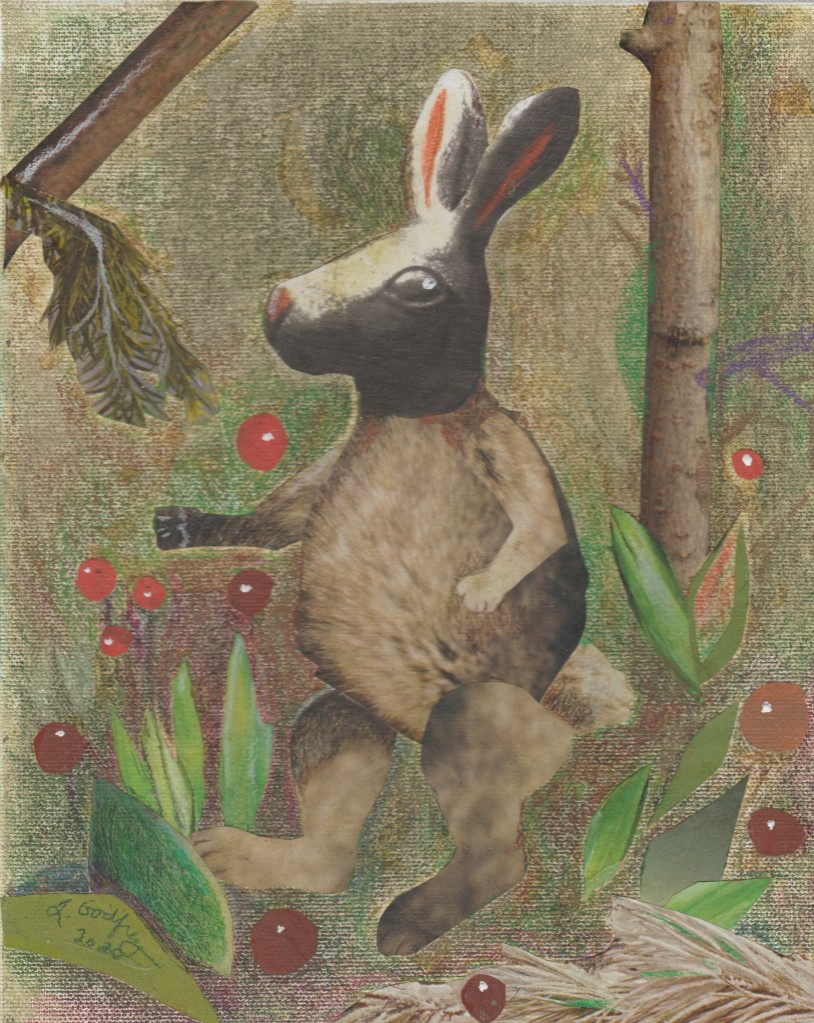
In this version, the five-foot tall, upright rabbit creature was seen by a woman working at a camp in Michigan’s Upper Peninsula in 1958, between Paulding and Bruce Crossing. The woman’s daughter said it ran away from her mother on two legs. The woman, whom I met at a book signing in Iron Mountain, said her mother wasn’t the type to make things up, and often marveled that she had seen such a thing. It also happens that this area is almost the exact spot of the famed Paulding Lights. The illustration is my own fanciful interpretation of the creature. Happy Easter!
Great Spirit Birds of Africa–in Colorado!
Posted in African art, animals, chupacabra, cryptozoology, cryptozoology art, giant birds, strange creatures, thunderbirds, Uncategorized, tagged animals, art, travel, wings on January 4, 2020|
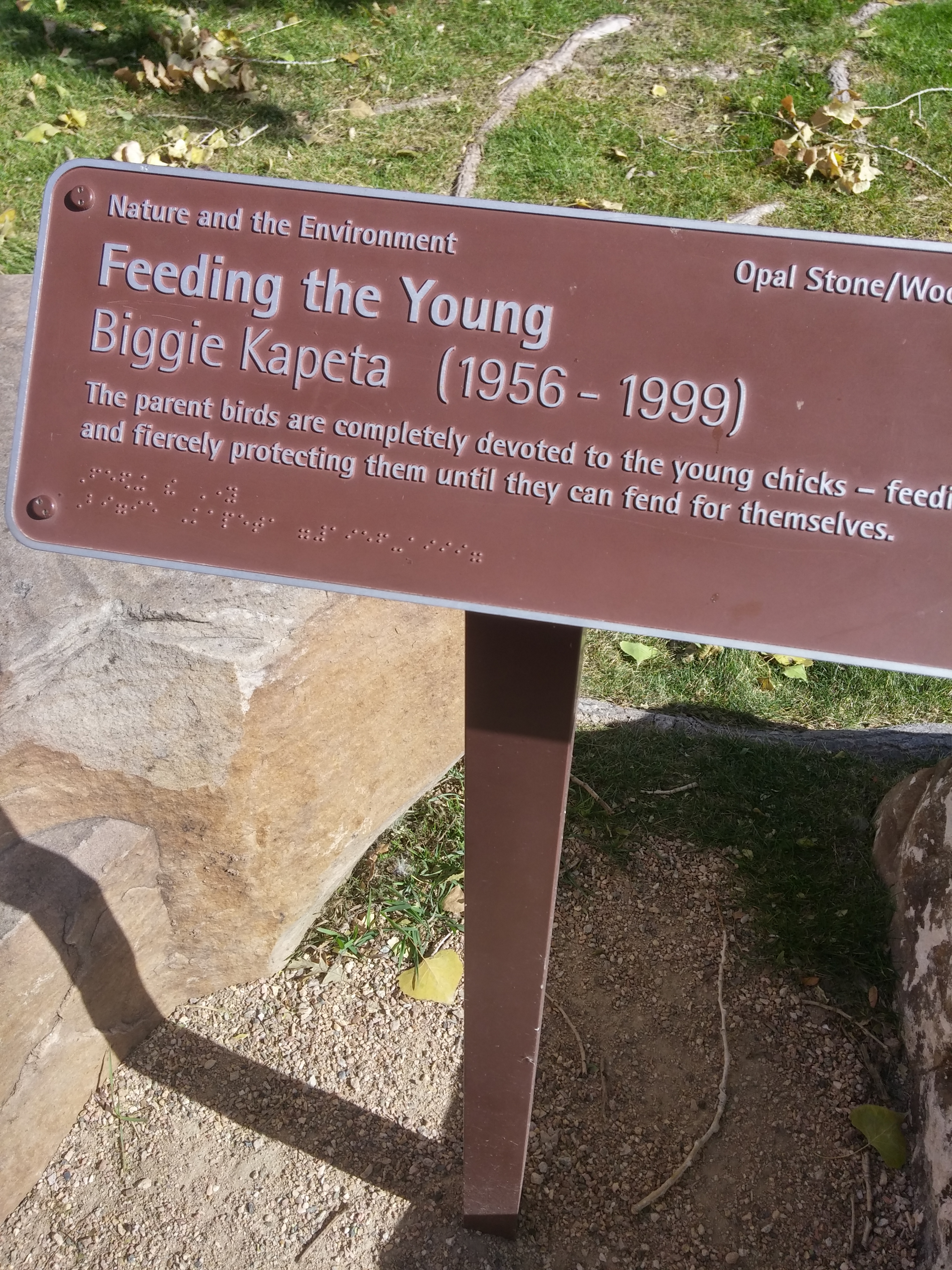
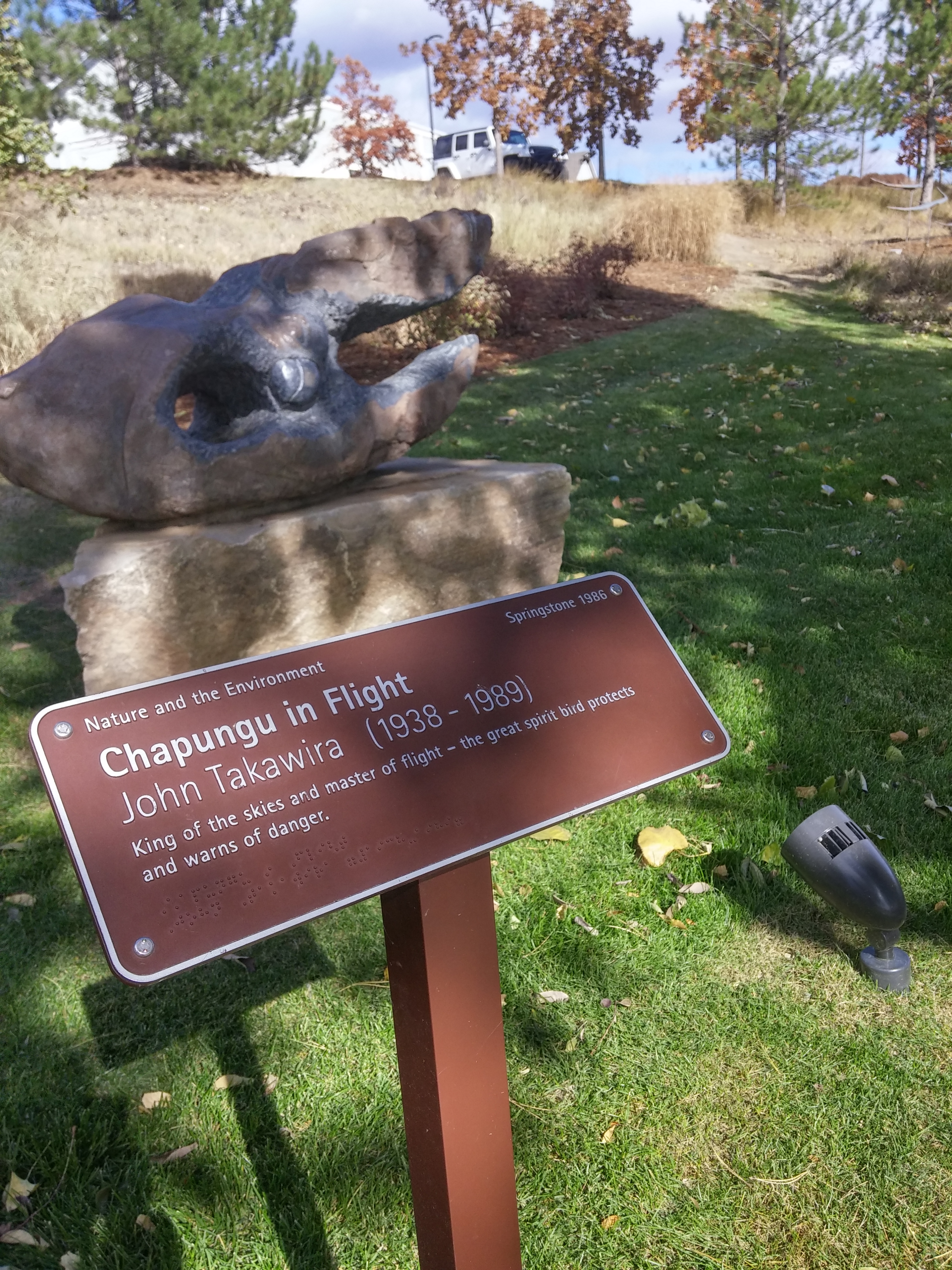
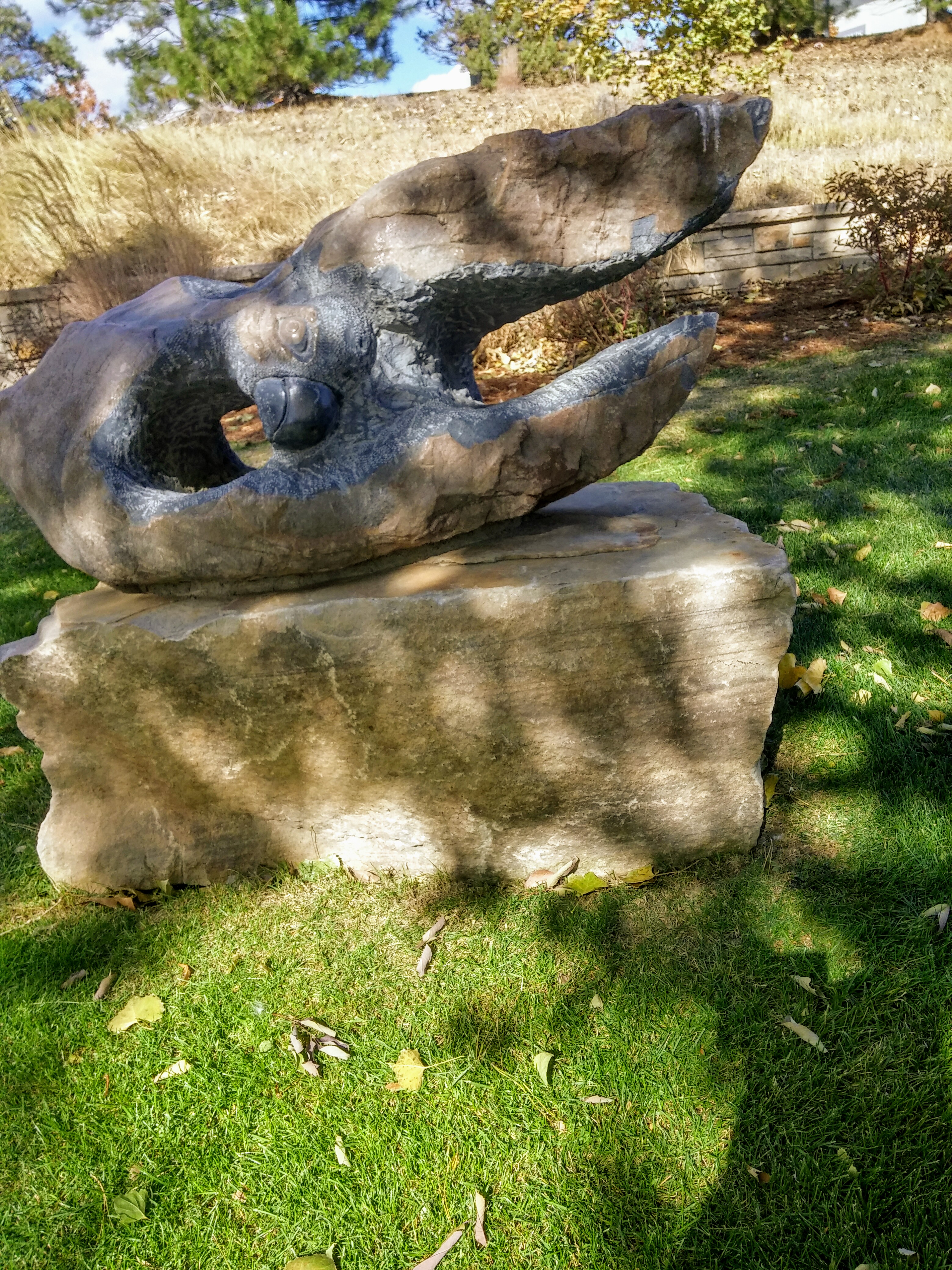
Great flying creatures–from giant humanoid bat-beasts to heavenly, silver-white, stork-like flyers–date back to the art and story cultures of most ancient civilizations around the world. Many of us are already familiar with ornithoids of early Sumerian and Egypt, Native American thunder birds, and other well-known examples, so it’s always a delight to find giant birds in places I’ve personally missed. A few months ago in Loveland, Colorado, my husband and happened upon just such a treasure. We were there to show a half-hour sneak peek of Return to Wildcat Mountain at Longmont’s Charles Dickens Horror Film Festival, when we found something lovely.
Here, the various types of Chapungu or “Great Spirit Bird” of Zimbabwe are depicted in stone sculptures created by modern-day African artists, the Shona people. The sculptures–with explanatory plaques–are displayed in a large, gracefully landscaped park. The Great Spirit Birds are said to protect the people and to warn of coming bad events (Pt. Pleasant’s Mothman and bridge collapse come to mind as an American parallel).
I’ve included a few of my own photos here but there are many more resources online. A good place to start is at http://www.chapungusculpturepark.com . (Note: Links have been a bit problematic) And keep looking up! Who knows what else is flying around up there, waiting for some writer or artisan to take lasting note?
Overnight rock design on my deck
Posted in animals, bigfoot, cryptozoology, cryptozoology art, Linda Godfrey, Uncategorized, unexplained phenomena, wildlife, tagged art, dogs, Life, nature, Rock designs on deck, Unknown rock design on November 26, 2019|

An overnight gift on my deck? Something unusual turned up this morning on my backyard deck which overlooks part of the Green Belt that connects hiking paths around the city where I live.
My bedroom window overlooks it directly. I once had a wired-in, infra-red motion detector focused on the yard there but something bit the wire in two! That was a few months ago. But just lately, I’ve been getting wood knocks in groups of 3 from the woods back there. Always a few minutes after I turned my light off.
A couple of nights ago, the knocks occurred immediately after I turned off my light. I told the Hubz but I wasn’t too excited, could have been lots of things. Last night around 8 or 9 pm some of the neighborhood dogs started barking in alarm mode. Again, I’d usually figure a deer or rabbit, coyote or whatever…until whatever was being barked at decided it had enough and made that super deep “hobita-hobita” growel + vowel sound that I and many others have associated with Brother Bigfoot or Sister Squatch. The barking stopped immediately. Again I mentioned it to my resident skeptic and he said, “Hmph.” So this morning I took a look out there and was shocked to see a perfect circle of 5 white landscape rocks laid out on the deck near the back rail. They had to have been carried from some edging close to the house. I know my neighbors…none of them would have sneaked onto my yard to make a little rock feature for me. The deck is surrounded by wilted plant debris so no footprints. Here are a few pix from my photo record. And the quarter and standard card deck are for size comparison, not a test to see if my visitor wants to ante up for a game of poker. BTW the woods were completely silent…no squirrels, birds etc. Eerie!
Halloween Old and New; Beast Arcana and Creature Socks
Posted in animals, bigfoot, Bray Road, cryptozoology, cryptozoology art, ghost cats, Halloween, Linda Godfrey, monsters, mountain lions, strange creatures, Uncategorized, unexplained phenomena, werewolves, Wisconsin history, wolfmen, writing, tagged art, beast of bray road, Life, socks, writing on November 1, 2019|
This Halloween offering is for those followers of the the Beast of Bray Road legend and encounters, who enjoy puzzling over the decades-old paper trail of ink-blotted arcana fished out of battered files. I recently found two such items hidden in a drawer in a folder I’d marked, “Old Beast.” They actually fell out of the folder and right in my lap–an old makeshift bookmark and a page torn from the small notebook I used in my early reporting days.
I was about to throw them in the circular file but then I noticed the words, “Bray Road Werewolf” at the top of the bookmark. Beneath it was what I believe were my first written words about witness Lori Endrizzi and her mother, Pat ; “Lady claims daughter saw a werewolf on Bray Road 2 years ago.” I had added “Hospital Road,” because the sighting was near Bray’s intersection with that shortcut to Walworth County’s hospital complex. (Some names are redacted.)

There were other brief comments from someone inviting me to cover a meeting on alleged mis-used animal traps, along with a mention of the county animal shelter where I later met with Jon Fredrickson, the county’s then animal control officer. The bigger piece of paper includes more notes on that meeting, and a great Fredrickson quote, “The county’s getting stranger.” And best of all are my notes on his description of a wolf or coyote springing up when startled so that it only seemed to be walking upright. And I can’t leave out the mention of the large, clawed animal trail on Potter’s Road.

For those who are not fans of very old paper trails, I give you (metaphorically), my growing collection of creature socks, all from friends, that also give me joy. Happy Halloween to ALL my friends, I just thank you all for being here.

New Big Cat Reports: The Black and the Tan
Posted in animals, Bray Road, cryptozoology, ghost cats, mountain lions, Uncategorized, unexplained phenomena, wildlife, tagged black panther, horror film fest, Iowa Van Meter Visitor Festival, mountain lions on September 22, 2019|
Reports picking up in SouthEAST Wisconsin?
Here’s a tail of a black and a tan, one 7 miles from Bray Road a few days ago and one less than two weeks on the southern outskirts of Janesville…

On Saturday, September 7, 2019, 25-year old Harley Marcum and fellow employee Robert Davis were between shifts outside the back door of a south Janesville company about 6:30pm, when something caught Marcum’s eye; a dark animal moving swiftly from the parking lot toward a nearby marsh, on all fours and low to the ground. “Holy crap! Look!” Marcum yelled at Davis, not believing his own eyes. Robert looked where Marcum was pointing just in time to see a huge black-furred animal skulk off into the grassy, marsh area, its glossy coat reflecting the waning sunlight. There was no doubt in either of their minds, said Marcum: It was a mountain lion or some other type of big cat.
(Click link for video of Marcum and Davis)
The two men exchanged startled glances, and then decided to run after the animal to see if they could scare it out for another look. A few steps into the field, however, they couldn’t see where it had gone and began to feel uneasy. They retreated to the parking lot, the edge of which was only about 20 feet from the marsh but didn’t catch another glimpse. They did tell a friend of theirs about it, and the friend contacted me. I met up with Marcum and Davis at their usual shift change time on Thursday, Sept. 19, where I looked around for prints and heard more of their story.

Harley Marcum points at marsh the big cat was frequenting
Where did the big cat go? Their employer’s location is in the general area east of Hwy. 51 on Janesville’s south side, but there are many open and wooded wild areas where the big cat could also easily rove. Male cougars need thirty-square-mile territories if they are planning to stay, and can cover many miles in a day if just passing through.
It Was a Beast
Both men described a rather formidable animal.
“It was weird,” said Harley, “like nothing I’ve ever seen. And I clearly seen it; it was bigger than a German shepherd.” In fact it was larger, he said, than what he would expect a mountain lion to be. “I could see the muscles, it was slick black. It was a beast,” he said. “I had a side view of the head, and I saw a long tail that curled upward and then curled down.” That is a standard mountain lion description.
Harley also noted that it had what seemed a big head for the body, which, together with the black fur that zoologists say is never seen on a mountain lion, may indicate some other species of big cat or a hybrid. Harley said they did not report their sighting to the DNR or other officials. They are now alert at every shift change, hoping for the privilege of seeing such an unusual animal again. “I’m extremely grateful,” said Harley of his encounter.
Sighting #2: Tan Cougar seen East of Bray Road
An even more recent report came to me by phone the day after it occurred, September 15, 2019, from a location only about 7 miles from the NE tip of Bray Road. The caller and his wife own a summer home and acreage in eastern Walworth County. They had first contacted me in November, 2018, after they found roundish, “large baseball” sized prints on their land and learned that only a few miles away, a farmer had lost two calves to an unknown predator. He had five trail cameras positioned around his property for the remainder of the winter, but nothing turned up on any of them. He contacted the DNR but was told it must be either a dog or a deer. He knew it was neither of those.
When the property owner called me last week, it was to tell me that the previous day, his wife had seen what she was sure was a tan mountain lion, walking only about 60 feet away from her bedroom window. She also noted its large, looping tail. She had good light and a longer look at it than most people. The couple prefers to remain anonymous.
And just south of the WI-IL Border:
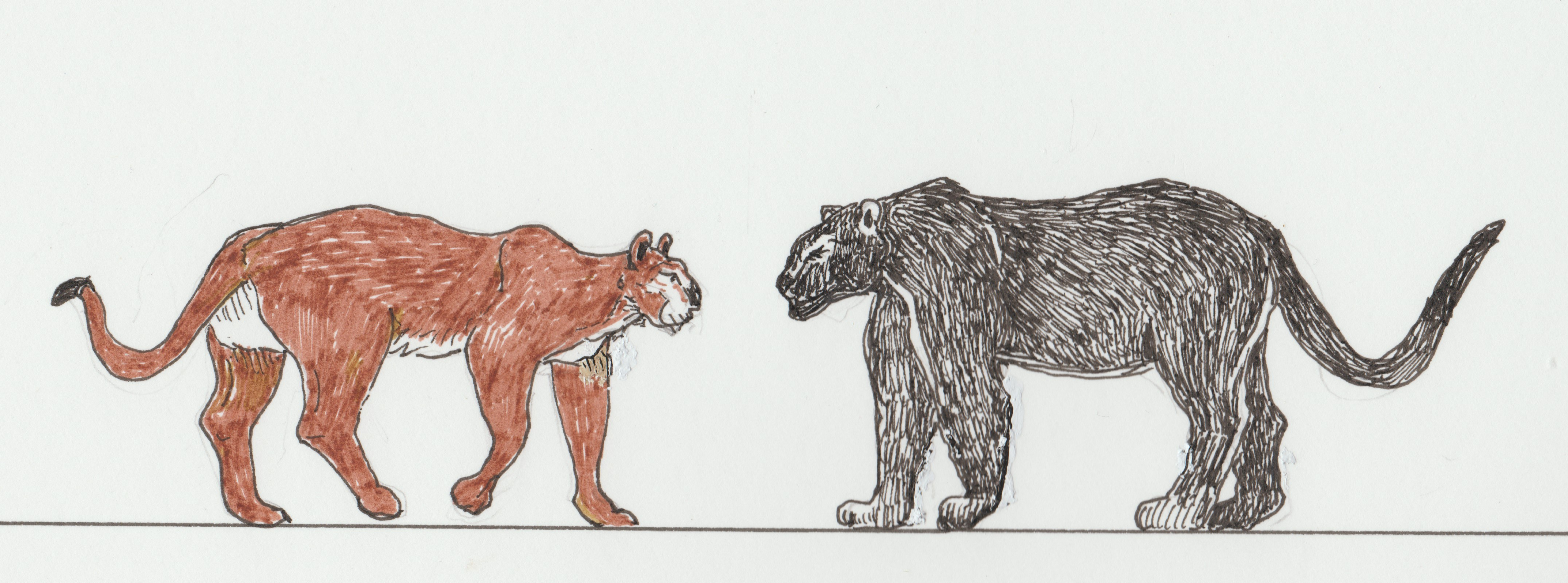
art by Linda Godfrey all rights reserved
Area newspapers ran articles in August, 2019, about an 11 p.m. sighting on August 8 of a dark brown, large animal with bright eyeshine. A couple was driving near the village of Rockton, IL, traveling north on South Bluff Road next to the Rock River when this occurred. They described the typically flat-faced head profile of a big cat and also the tell-tale tail that appeared to be “curling under” as it crossed the road in front of their car. They insisted it was not any well-known or usual animal seen in that area.
Readers of my blog will know that I’m working on a documentary called Return to Wildcat Mountain about the surge of tan AND black big cats in central Wisconsin west of the Baraboo area. You can see the trailer at https://www.youtube.com/watch?v=BTc-t85UeDw and short versions will be shown at Iowa’s Van Meter Visitor Festival just west of Des Moines September 28, and at the Charles Dickens Horror Festival in Colorado on October 19, 2019 for starters. More to come!
Note: For a fuller story of the Rockton IL sighting please see Singular Fortean’s story singularfortean.com/news/2019/8/28
Wing-Things Over Chicago? Adding one Fluttering Thought
Posted in cryptozoology, cryptozoology art, giant birds, strange creatures, Uncategorized, unexplained phenomena, tagged chicago flyers, man bats, wings on August 9, 2019|

witness sketch of the Man-Bat of La Crosse, WI, 2006
My favorite motto is “Always look behind you, always look up.” And there seems to be a lot more reason over the past few years to obey that second half of the saying.
Although they’ve proven quite controversial, many dozens of giant, flying, sometimes bat-like creatures have been spotted above the city of Chicago and its environs in the past few years by a variety of eyewitnesses. This isn’t entirely new. There have been similar reports from around the US for decades, such as those describing Point Pleasant’s Mothman, Tacoma’s famed Batsquatch and others including the creature I called the Man Bat that almost flew right into the windshield of a truck on a country road near La Crosse, WI the night of September 26, 2006. I investigated that one on site quite soon after it was seen, and also heard from other area people who’d encountered it. Overall, these and the other eyewitnesses reporting sightings across the country seem as credible to me as any other group of cryptid spotters, and I do believe this is a phenomenon worthy of investigation.
I could not help wondering, though, why some–again, FAR from all–of the Chicago flyers were appearing over popular tourist areas such as Lincoln Square, the Gold Coast and the Art Institute of Chicago. Most cryptid sightings occur in rural or at least liminal places; the outskirts of a city rather than the downtown, for instance.
The Art Institute sighting reminded me of something I’d written in a 2009 book titled “Mythical Creatures” for the Chelsea House series, Mysteries, Legends and Unexplained Phenomena, edited by my late, great and dear friend Rosemary Guiley. (The book includes the story of the La Crosse Man Bat on pages 33-34.) Also, my youngest son has an art degree from the School of the Art Institute of Chicago (SAIC), and had some first-hand knowledge of various projects people were working on.
Before I go any farther, I want to be clear; I’m offering this idea only for what it’s worth—and only as it may provide insight to some encounters with the sky critter phenomenon. There are other ideas and theories out there. I’m not offering a solution or even a suggestion that any particular individual has been involved with the origin of these unknown flyers in any known way. But let’s look at one chapter, “Mixed Up Monsters,” of the book mentioned above.
My research on that chapter back in 2009 had led me to the various, publicly exhibited works of an art professor at SAIC named Eduardo Kac (pronounced Katz) who’d become famous for his claim that he had produced a rabbit/jellyfish chimera named Alba that glowed green under black lights. The exhibition intended to display Alba to the world never happened, however. And more importantly to our discussion here were another facet of Kac’s work involving remote-controlled, bat-like robotic figures complete with sonar. Many researchers have studied and written about these bat-bots.
One such writer, a Stanford student named Thomas Loverro, offered a paper in the Stanford Undergraduate Research Journal on Kac’s work, divided into sections titled telepresence, biotelematics, robotics and transgenic art. https://web.stanford.edu/class/sts129/essays/Loverro2.htm
These artworks were created not with brushes or chisels, but with the latest scientific equipment. Or as a Dec. 12, 2018 Chicago Reader article put it, “…SAIC’s Bio Art Lab, where art is life—literally.” This futuristic genre had garnered its own space at SAIC, a lab in the basement of the MacLean Center at 112 S. Michigan.
Loverro also wrote “… [Kac’s] 1999 Darker Than Night interactive exhibit, which is a culmination of the works examined thus far. It brings computers, robots, animals, and humans together and asks them all to communicate with each other. Kac placed a robotic bat (“bat-bot”) in a cave with over three hundred Egyptian Fruit Bats in a zoo. The robotic bat was equipped with the ability to convert real bats’ high-frequency calls to within the audible range of humans and also rotate its head, where the sonar microphone was located. Human listeners could then remotely, via a virtual reality headset, turn their head to control the bat-bot’s microphone and immerse themselves in the world of the bat.”
Kac’s “bat-bot,” then, literally hung out with living bats.
SO…it could be mere coincidence. But since Kac is a Professor Emeritus at SAIC, and is undoubtedly well known to a generation of art students and other artists, could it also be that some follower or admirer of his work may have seen some of the early Chicago Flyer reports, remembered the bat-bots and designed one with drone technology for some short flights above downtown Chicago? Over the Art Institute? Where there is an art-bio-lab? I emailed Kac at his SAIC address to see if he had any idea whether such experiments were being undertaken in the school or elsewhere, but did not receive an answer. It’s possible he never received my inquiry. And also very possible he has never heard of Chicago’s flying things.
Again, this is all mere speculation and not a suggestion that any particular person, known or unknown, is involved. It doesn’t explain sightings in any other places, either, especially those in other states. But I do think it’s a good example of how in this day and age, investigators need to look outside the cave to explore all possibilities. At least knowing that bat-bots and other bio-mechanical-genetic “things” are being invented may help keep us looking up.




